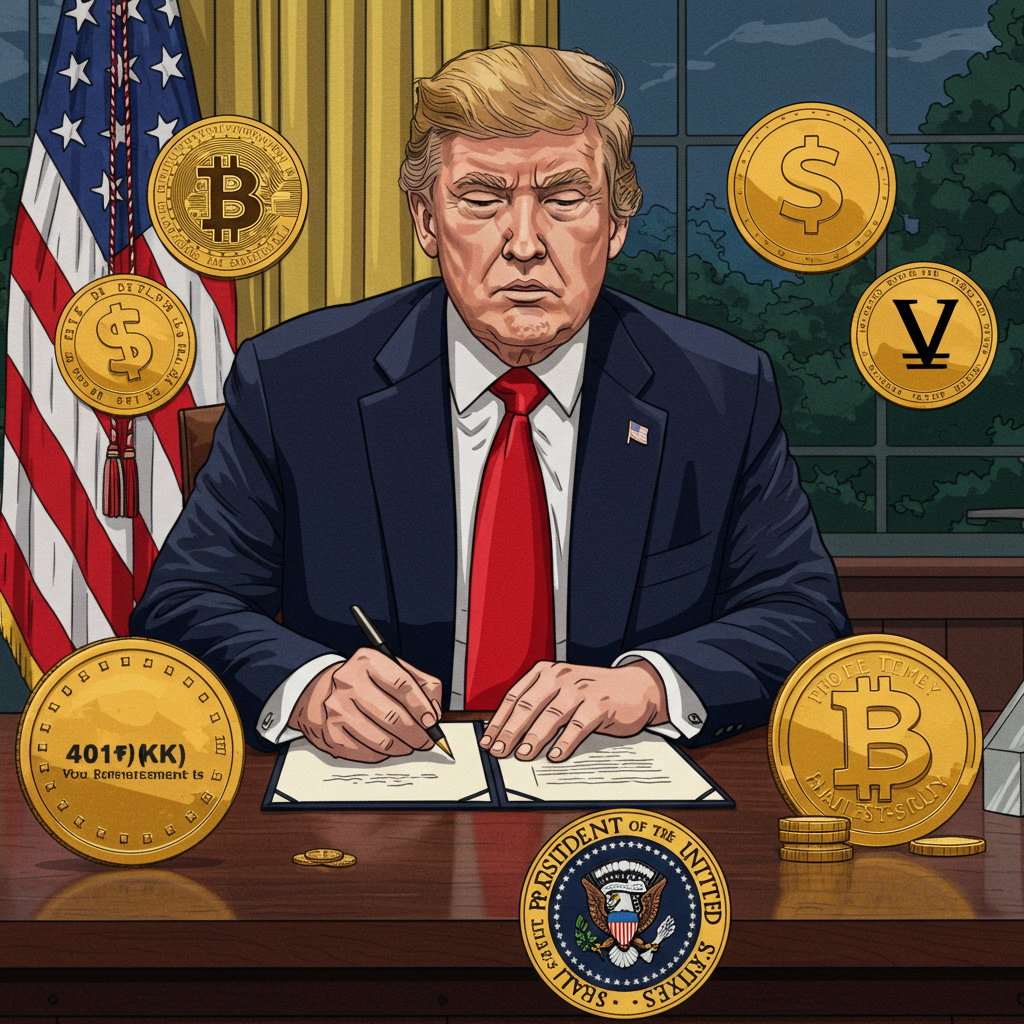A significant shift is underway in American retirement planning. A recent executive order signed by President Donald Trump aims to fundamentally alter how millions of Americans can invest their 401(k) and other defined-contribution retirement savings. This directive opens the door for these accounts, which collectively hold trillions of dollars, to invest in alternative assets. Specifically, it targets private equity, cryptocurrency, and real estate, traditionally reserved for institutional or ultra-wealthy investors.
This potential overhaul presents both compelling opportunities for higher returns and substantial, unprecedented risks for everyday savers. Understanding these Trump 401k changes is crucial for protecting and growing your retirement nest egg. This guide will break down what’s happening, the potential benefits, the critical dangers, and what you should consider for your financial future.
Unlocking New Horizons: What the Executive Order Entails
President Trump’s executive order directs key federal agencies to re-evaluate and clarify their stance on alternative assets within retirement accounts. The Department of Labor (DOL) is tasked with re-examining its guidance to allow a clearer path for private market investments, real estate interests, and digital assets. Concurrently, the Securities and Exchange Commission (SEC) is directed to explore ways to facilitate access to these assets for plans like 401(k)s.
This move potentially “opens the floodgates” for new investment avenues. Currently, while private equity is technically permissible in some retirement plans, it remains rare. Similarly, direct cryptocurrency investments in 401(k)s are uncommon, with many recordkeepers lacking support. The executive order aims to dismantle these barriers, potentially giving financial managers access to a vast pool of American retirement capital.
The Allure of Alternatives: Why Proponents Support the Shift
Advocates for including alternative investments in 401(k)s highlight several perceived benefits. The Trump administration and groups like the Securities Industry and Financial Markets Association (SIFMA) argue that these assets can offer a broader menu of investment opportunities. Kenneth E. Bentsen Jr., President and CEO of SIFMA, emphasized that private markets have matured into a robust asset class as more U.S. companies remain non-public. Expanding access, he believes, could “improve diversification, democratize access, and offer more investment choices to the benefit of everyday retirement savers.”
Experts like Simon Tang, head of U.S. at Accelex, a private markets specialist, echo this sentiment. He states that these asset classes have “matured into a strong-performing asset class delivering excellent long-term returns.” Historically, private equity has shown promising performance. Cambridge Associates data indicates private equity assets yielded an average annual return of approximately 13% net of fees since 1990, often outpacing the S&P 500’s ~10.6% annual return over the same period. For a portion of a portfolio, some argue a small allocation to cryptocurrency could also make sense for its potential “risk-adjusted upside,” as noted by Cory Klippsten, CEO of Swan Bitcoin. Vanguard, a major retirement provider, also acknowledges private assets could offer broader diversification and potentially higher returns for investors with appropriate risk tolerance and a long-term horizon.
Navigating the Minefield: Understanding the Significant Risks
Despite the touted benefits, a broad consensus among financial experts points to substantial risks associated with these Trump 401k changes. Critics warn that this could put people in danger of losing a huge chunk of their retirement savings.
Transparency and Liquidity Concerns
One primary concern is the inherent lack of transparency and liquidity in private markets. Robert Brokamp, a financial planning expert at The Motley Fool, explains there is “a lot less transparency and liquidity in private markets.” Information about underlying companies is scarcer. It could also be “hard to sell your investments — especially during a panic and many, many investors are trying to sell at the same time,” Brokamp warns. Private equity investments, for instance, often lock up capital for years, making them far less liquid than publicly traded stocks.
Higher Fees and Eroding Returns
Alternative investments typically come with significantly higher fees than traditional 401(k) options. Benjamin Schiffrin, director of securities policy at Better Markets, highlights this disparity. While target-date mutual funds holding stocks and bonds might charge around 0.3% in fees, private funds can charge 1% to 2% in management fees. They may also include up to 20% in performance fees. Interval funds, another alternative, can charge 2% to 3%. Pitchbook analysts note that costs associated with private companies, such as travel and legal work, are often passed directly to fund investors. A 2024 report by the Center for Retirement Research at Boston College suggested that higher-fee options could reduce retirement income by up to 17% over a 30-year period. These elevated costs can significantly erode potential returns over time.
Volatility and Lack of Protection
Cryptocurrencies present a “whole separate category of risks,” according to Schiffrin. “It’s not clear what, if any, protections investors are going to have when it comes to investing in crypto.” Federal regulators, under the Biden administration, had advised treating cryptocurrency with “extreme care” due to its significant volatility. Bitcoin, for example, can experience daily price swings of 10% or more, a level of fluctuation rare in the stock market. While it has trended upward historically, its sharp declines (e.g., dropping 65% one year compared to a 19% S&P 500 loss) underscore its unpredictable nature.
Potential for Irreversible Losses
Anh Tran, a certified financial planner and attorney at SageMint Wealth, believes there is a real risk. Less-informed investors might be drawn in by the allure of potentially higher returns without fully grasping the risk of losing money entirely. “It could be detrimental to less-informed investors whose only investment account is their 401(k),” Tran stated. She stressed the need for “proper guardrails, such as limiting exposure to 5% to 10% of the portfolio.” Without these limits, investors could face “unnecessary risk, misaligned expectations and potentially irreversible losses.” Knut Rostad, co-founder of the Institute for the Fiduciary Standard, fears a “massive train wreck” if these changes proceed without adequate safeguards, leading to the “annihilation” of many retirement accounts.
Implementation: A Long and Cautious Road Ahead
Despite the executive order, immediate changes to your 401(k) investment menu are highly unlikely. The implementation process is expected to be lengthy and complex, taking months or even several years.
First, the Department of Labor must provide new guidance clarifying permissible assets under ERISA (Employee Retirement Income Security Act of 1974). This act mandates that employers offer retirement options in their employees’ best interest. Only after new regulations are in place will employers have the option to offer a wider array of investment choices.
Even then, employers would have to decide whether to offer these new options. Experts anticipate many might be reluctant, fearing potential legal liability for losses. Ted Rossman, a senior industry analyst at Bankrate, predicted that adoption would be slow. He noted that many 401(k) providers are hesitant due to worries about costs, legal liabilities, and other consequences. While updated government guidance might provide some comfort, many experts still believe widespread adoption could be detrimental.
Major retirement plan companies like Fidelity and Vanguard will also need time to develop and vet appropriate funds for these alternative assets. Pitchbook analysts predict “slow adoption due to cost, transparency and complexity.” Ultimately, workers would still retain the option to limit their investments to traditional assets or opt out of adding new alternative strategies to their portfolios. It remains uncertain how many employers or workers will choose these new asset classes.
What This Means for Your Retirement Strategy
The executive order marks a pivotal moment, but it’s not a green light for impulsive action. Experts emphasize that education and safeguards are paramount, especially for younger investors and those without access to professional financial advice.
For current retirement savers, the advice is clear: stay informed, understand all associated fees, and exercise extreme caution with high-hype investments like crypto. Before making any changes, consult with a fiduciary financial advisor. This professional can help you align potential new options with your long-term financial goals and personal risk tolerance.
Crucially, you are not mandated to invest in these new asset classes if your employer eventually offers them. You can continue to prioritize traditional, well-understood investments like mutual funds and ETFs, which Ted Rossman generally recommends for their simplicity, ability to match market performance over time, and low fees. Transparency, education, and limits are key to preventing widespread financial harm and ensuring your retirement remains secure.
Frequently Asked Questions
What types of alternative assets are now being considered for 401(k)s?
The recent executive order aims to clear the way for 401(k) retirement savings to be invested in alternative assets such as private equity, cryptocurrency, and real estate. These investment types were historically less common or inaccessible within typical employer-sponsored retirement plans. The directive pushes federal agencies like the Department of Labor and the SEC to update regulations to facilitate access to these assets.
What are the main risks associated with investing in private equity or crypto in a 401(k)?
Investing in private equity or cryptocurrency within a 401(k) carries several significant risks. These include less transparency and liquidity compared to traditional investments, making it hard to get information or sell quickly. Fees are substantially higher, with private funds charging up to 20% in performance fees, eroding returns. Cryptocurrencies are highly volatile, experiencing large price swings and lacking clear investor protections, which could lead to significant and potentially irreversible losses for less-informed investors.
Should I immediately change my 401(k) investments to include these new options?
No, immediate changes to your 401(k) are highly unlikely and generally not advised. The implementation process for these new investment options is expected to be slow, taking months or even years as federal agencies provide new guidance and employers decide whether to offer them. Financial experts recommend caution, emphasizing the need for thorough education and consultation with a fiduciary financial advisor to understand the risks and ensure any investment decisions align with your long-term financial goals and risk tolerance.
This executive order marks a new chapter in U.S. retirement investing. While it presents opportunities for diversification and potentially higher returns, the risks are substantial. Informed decision-making, professional advice, and a clear understanding of your personal financial situation will be crucial as these changes unfold.


